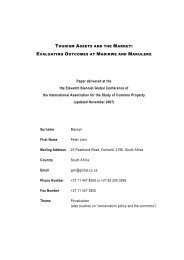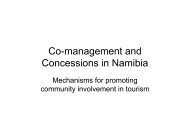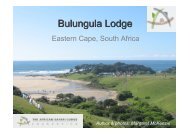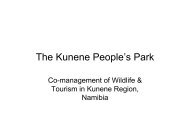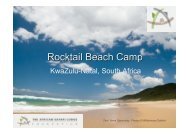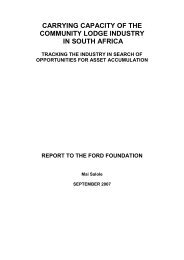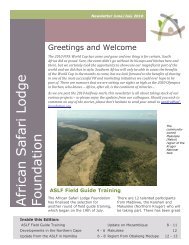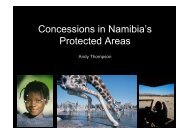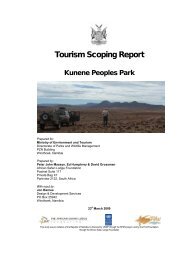Tourism Development Plan Khomani San Community - The African ...
Tourism Development Plan Khomani San Community - The African ...
Tourism Development Plan Khomani San Community - The African ...
Create successful ePaper yourself
Turn your PDF publications into a flip-book with our unique Google optimized e-Paper software.
TOURISM DEVELOPMENT PLAN - ‡KHOMANI SAN COMMUNITY<br />
Activities<br />
<strong>The</strong> concessionaire will be permitted to offer the following activities:<br />
• day and night drives in the concession area using SANParks-compliant game-viewing vehicles;<br />
• day drives on public roads outside the concession area using SANParks-compliant game-viewing<br />
vehicles;<br />
• guided walks in the concession area, elsewhere in the V-Zone and, possibly, in the ‡<strong>Khomani</strong> <strong>San</strong><br />
portion of the !Ae!hai Kalahari Heritage Park; and<br />
• cultural performances and interactions involving the ‡<strong>Khomani</strong> <strong>San</strong>.<br />
Environmental considerations<br />
<strong>The</strong> following important environmental issues should be taken note of during the EIA procedure:<br />
• In general, the lodge should be designed to have as light a footprint as possible in all respects, taking<br />
cognisance of all salient environmental features as well as making use of recent technological and design<br />
alternatives.<br />
• Availability of water in sufficient quantity and acceptable quality to be determined by professional geohydrologist.<br />
• Ideally, renewable energy sources such as solar power should be utilised and the use of generators, gas<br />
and paraffin should be limited. Energy saving devices should be incorporated in the design phase of the<br />
development.<br />
• Solid waste must be responsibly and legally disposed of at a registered land fill site. A waste<br />
minimisation policy should be adopted and recycling is a requirement. Waste water should be separated<br />
into grey and black streams so that water can be recovered and reused. Sewage must be appropriately<br />
treated and disposed of. Water conservation must be practised at all times and water saving devices<br />
should be incorporated in the design phase, including dual flush toilets, low flow taps and shower heads,<br />
etc. Water consumption must be monitored, recorded and evaluated regularly.<br />
Implementation method<br />
<strong>The</strong> implementation method will depend on the outcome of the feasibility assessment referred to<br />
below and agreement between the ‡<strong>Khomani</strong> <strong>San</strong> and SANParks. However, it is recommended<br />
that the following principles be applied:<br />
• <strong>The</strong> concession should be developed using a build, operate, transfer approach.<br />
• <strong>The</strong> concession should be awarded to an appropriately qualified private partner via a competitive bidding<br />
process.<br />
• [TENDER RULES TO BE ADVISED PENDING LEGAL ADVICE AND CLARIFICATION OF<br />
SANPARKS POLICY/APPLICABILITY OF PPP RULES] 2<br />
2<br />
According to Hathorn (pers. comm., 2010), the ‡<strong>Khomani</strong> <strong>San</strong> CPA is not a government institution as defined in regulation<br />
16 of the Public Finance Management Act (No. 1 of 1999) thus any project of the ‡<strong>Khomani</strong> <strong>San</strong> in the V- Zone would not<br />
qualify as a public-private partnership. Conversely, any project of SANParks in the V- Zone would, if private parties were to<br />
be involved. More recently, SANParks have expressed a contrary opinion, arguing that PPP regulations did indeed apply<br />
but that implementation could proceed rapidly due to the good working relationship between Treasury and SANParks.<br />
PAGE 48



